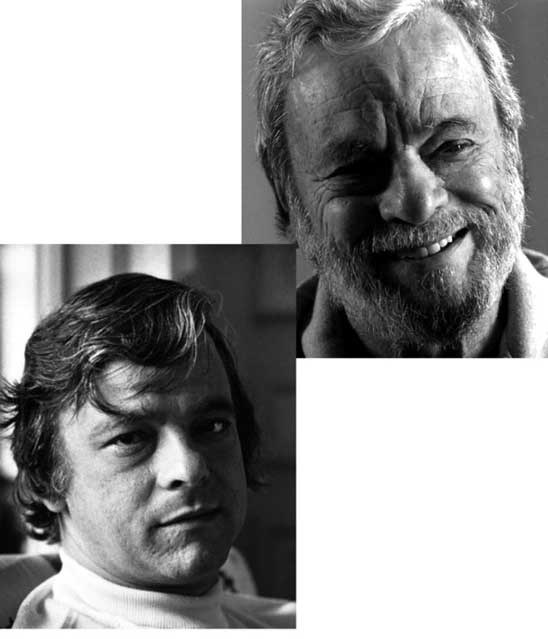The ages of Stephen Sondheim: Embracing his talent with none of the false modesty that sometimes mars the self-reflections of gifted artists.Sondheim's Lyrics: Rhymes, Reasons and Religion
By Michael Sigman
Though I grew up in an agnostic household, I was rarely in doubt that a spiritual force was afoot. Music, specifically what's come to be called "The Great American Songbook," was our religion. The Word, if you will, could be found in the lyrics of Porter, Berlin, Hammerstein and Mercer. And there was a Genesis of sorts each time my dad, Carl Sigman, created a new song, often in a tiny fraction of the proverbial seven days.
The Sigmans particularly enjoyed worshipping at the altar of Stephen Sondheim, whose recent book Finishing the Hat—the complete lyrics, with commentary and annotations, to his body of work from 1954-1981—comes as close to holiness as many a religious text. The song that gives the book its title—it was written for 1983's Pulitzer-winning Sunday in the Park with George, so its lyrics are not included—is about how a work of art emerges out of nothingness into being.
Sondheim embraces his talent with none of the false modesty that sometimes mars the self-reflections of gifted artists. Nor does he hesitate to give the reader a thrilling narrative of his own songwriting "sins," including such cardinal transgressions as "redundant adjectival padding," "anachronism," "architectural laziness" and "strained joke." I won't give examples here for fear of detracting from the Olympian heights of the master's descriptions.
Bernadette Peters and Stephen Sondheim (introduction and piano accompaniment), ‘Send In the Clowns’Sondheim's exegesis on why perfect rhymes perfectly stressed are better, especially in musical theater, than their black sheep relatives—near rhymes, identities and such—is pure godhead. (He doesn't stoop to acknowledge the deadly sin of the absence of rhyme when one is clearly called for. For example, the usually wondrous Stevie Wonder writes, in one of his biggest hits, "I just called to say I love you /I just called to say I care/ I just called to say I love you/ and I mean it from the bottom of my heart." At the end of the phrase, the ear expects a rhyme with "care"—what Sondheim calls the "snap" of recognition that helps the listener make sense of what's happening.
When one hears "heart" instead, it's a letdown, if not a betrayal. Given Wonder's impressive locks, perhaps better to go with the ear-pleasing, "And I love you from the bottom of my hair." (The possibilities for a true rhyme here are endless: an agoraphobic might want to substitute "lair," a friendly Frenchman "mon frere," a stolid German "mein herr," etc.)
Songwriters are always in search of the perfect perfect rhyme, what my dad called the "ideal wedding" of words to music. (In his last hit, "(Where Do I Begin) Love Story” the marriage hit a rocky patch when he employed the pseudo-rhyme "mine"/"time" because, he said, everyone else was doing it.) It can be both humiliating and exhilarating (perfect rhyme? I report, you decide) to read Sondheim's evisceration of the faulty rhymes and other sins of such iconic lyricists as Lorenz Hart, Alan Jay Lerner and Noel Coward. Humiliating because you never noticed some of the genuine flaws he points out, though he seems more spiteful than insightful when chastising Hart for the delightful (triple inner rhyme intended) rhyme of "laughable and unphotographable" in "My Funny Valentine". Exhilarating because you can still adore these writers' songs even as you gain a deeper appreciation for the granular details of world-class songwriting.
Stephen Sondheim interviewed by Jeffrey Brown on his book Finishing the HatIn the introduction to Finishing the Hat, Sondheim goes to great lengths to explain the hazards of reading song lyrics without the tunes that go with them. (Hammerstein's words to "Oh What A Beautiful Mornin',” for instance, look lame on the page, but take flight when sung to Richard Rodgers' soaring melody.) He's right, of course, but he also knows there are heavenly pleasures in store for those with a bit of imagination.
Carol Burnett, ‘The Ladies Who Lunch,’ from Stephen Sondheim’s Company.The annotated drafts of the scores from the astonishing Company or Follies, of which Sondheim is particularly proud, or those from West Side Story, for which he gives himself very low marks, offer a glimpse into a process that can inspire our own modest exercises in creativity. (I interviewed Sondheim once and committed the sin, venial I hope, of telling him how much I loved West Side Story. He responded with irritation and condescension; having now read his detailed critique, I can better understand his reaction, though, God forgive me, I still love the songs.)
If you're already familiar with Sondheim's melodies, you can perform the numbers yourself—in the shower, with friends or just in your mind—without having to memorize the lyrics. If you've never heard them—as I hadn't with Sondheim's first show, 1954's Saturday Night—you can invent your own tunes, then listen to the actual ones and discover just how tough it is to write a good song. Though I have to say, my fantasy version of Saturday Night's "Isn't It" isn't half bad. Isn't that rich?
Writer/editor, media consultant, music publisher Michael Sigman is a regular Huffington Post blogger. Follow Michael Sigman on Twitter: www.twitter.com/majorsongs
Stephen Sondheim’s Finishing the Hat is available at www.amazon.com
THE BLUEGRASS SPECIAL
Founder/Publisher/Editor: David McGee
Contributing Editors: Billy Altman, Laura Fissinger, Christopher Hill, Derk Richardson
Logo Design: John Mendelsohn (www.johnmendelsohn.com)
Website Design: Kieran McGee (www.kieranmcgee.com)
Staff Photographers: Audrey Harrod (Louisville, KY; www.flickr.com/audreyharrod), Alicia Zappier (New York)
E-mail: thebluegrassspecial@gmail.com
Mailing Address: David McGee, 201 W. 85 St.—5B, New York, NY 10024
Founder/Publisher/Editor: David McGee
Contributing Editors: Billy Altman, Laura Fissinger, Christopher Hill, Derk Richardson
Logo Design: John Mendelsohn (www.johnmendelsohn.com)
Website Design: Kieran McGee (www.kieranmcgee.com)
Staff Photographers: Audrey Harrod (Louisville, KY; www.flickr.com/audreyharrod), Alicia Zappier (New York)
E-mail: thebluegrassspecial@gmail.com
Mailing Address: David McGee, 201 W. 85 St.—5B, New York, NY 10024


